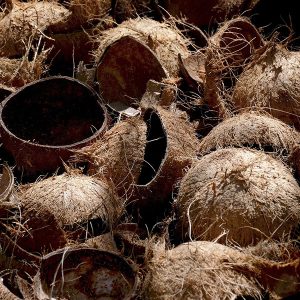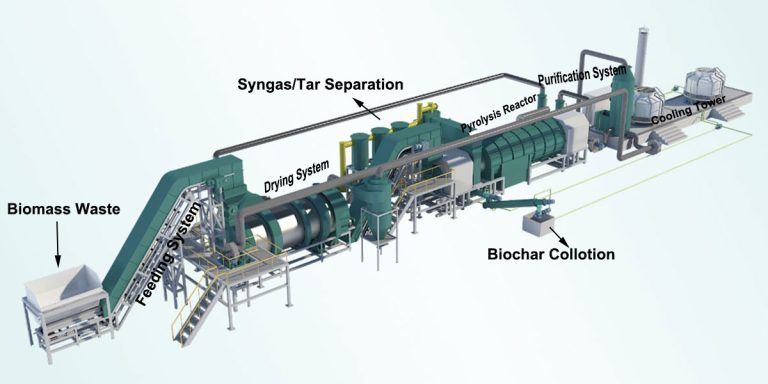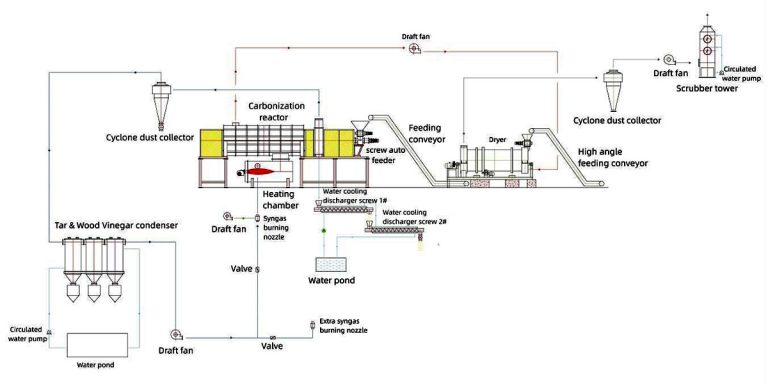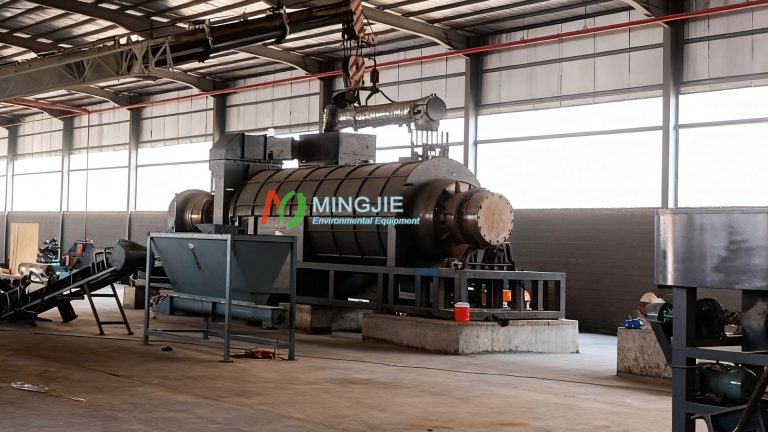Coconut shell charcoal making machine converts coconut shell charcoal produces by pyrolysis carbonization process. The coconut shell charcoal machine adopts a fully continuous working mode, and can operate continuously for 24 hours.
Coconut Shell Charcoal Making Machine for Sale
According to the different biomass carbonization plant structures, Mingjie coconut shell charcoal making machine can be divided into skid-mounted small carbonization equipment and modular fully automatic coconut shell charcoal making machine.

Small Carbonization Equipment
The skid-mounted biomass carbonization plant adopts a single-barrel reactor structure. It is generally used as a verification machine. The fully continuous carbonization system requires the materials to be size smaller than 20mm, and moisture smaller than 15%.
Fully Automatic Biochar Making Machine
The modular fully automatic carbonization equipment adopts a double-barrel design. The double-barrel reactor can improve the continuity and reliability of the use of pyrolysis equipment, and realize the integration of material drying and carbonization.

If you’re interested in purchasing or learning more about biomass pyrolysis machines, you can contact Mingjie Group. Let me know if you need help finding specific models!
| Model | MJT-100 | MJT-500 | MJT-1000 | MJT-2000 | MJT-3000 | MJT-5000 |
| Input Capacity | 50-100kg/h | 300-500kg/h | 800-1000kg/h | 1500-2000kg/h | 2500-3000kg/h | 4500-5000kg/h |
| Structure | Skid Mounted | Modularized | Modularized | Modularized | Modularized | Modularized |
| Reactor Type | Single Layer | Dual cylinder | ||||
| Working Method | Fully Continuous | |||||
| Reactor Material | 304 Stainless steel | |||||
| Feedstock Size | <20mm | |||||
| Feeding Moisture | <15% | |||||
| Initial Heating Oil Consumption | 20L | 30-40L | 35-50L | 50-70L | 80-90L | 120-140L |
| Land Area | L12m*W2.5m | L29m*W12m | L34m*W13m | L36m*W15m | L42m*W15m | L50m*W18m |
Biomass Pyrolysis Carbonization Project
Distribution of Coconut Shells

Coconut shell is mainly distributed in tropical and subtropical areas, especially in Southeast Asia, South Asia, the Pacific region, Africa, Latin America, the Caribbean, the Middle East and some parts of Australia. These areas have developed coconut tree planting industry and abundant coconut shell resources, which have high economic and environmental value.
Coconut shell can be converted into coconut shell charcoal by coconut shell charcoal making machine. Coconut shell charcoal has a wide range of application prospects, and is used to make activated carbon, handicrafts, and fuel.
Coconut shell charcoal has high specific surface area, high adsorption performance and good conductivity. It is widely used in water treatment, air purification, soil improvement, energy storage and other fields. The thermal efficiency of coconut shell charcoal machine reaches 70%~90%, and the energy saving effect is good. It contains a multi-stage purification device to effectively filter out harmful substances.
If you’re interested in purchasing or learning more about Coconut Shell Charcoal Making Machines, you can contact Mingjie Group. Contact us for a free quote!
Composition of Coconut Shell Charcoal Making Machine

The Coconut Charcoal Making Machine mainly consists of the following parts:
- Feeding system: It is used to feed coconut shell raw materials into the carbonization furnace. It includes a conveyor belt, a screw feeder or a manual feeding device.
- Combustion Heating System: Usually, electric heating, gas heating or biomass combustion heating is used. The heating system needs to be precisely controlled to ensure the carbonization effect.
- Carbonization furnace: It is the core equipment. It is mainly used to heat coconut shells under oxygen-limited conditions to make them undergo pyrolysis and carbonization reactions. Carbonization furnace types include continuous carbonization furnaces and batch carbonization furnaces. Continuous carbonization plant is suitable for large-scale production and have high efficiency. Batch biomass carbonization machine suitable for small-scale production and are flexible to operate.
- Condensation cooling system: Water circulation cooling is mainly used. It is used to cool the coconut shell charcoal after carbonization to prevent it from spontaneous combustion.
- Electronic control system: It is used to monitor and adjust parameters such as temperature, feed rate, cooling time, etc. It ensures the stability and safety of the coconut shell carbonization process.
- Flue gas treatment environmental protection system: Used to treat the combustible gas and tar produced during the carbonization process. It usually includes a condenser, a filter and a combustion device.
- Discharging system: used to collect and transport carbonized coconut shell charcoal. It includes discharging port, conveyor belt or collection box.
Coconut Shell Charcoal Making Process

Crushing and Drying
Coconut shells with a moisture content higher than 15% and a size greater than 20mm need to be pre-processed. They need to enter the crusher for crushing and the dryer for drying.
Carbonization
The carbonization main furnace is preheated, and the dried material is then conveyed to the feeder. Then it enters the carbonization main furnace for carbonization. Under anaerobic conditions, when coconut shells are heated to a certain temperature (400-600°C), pyrolysis and carbonization reactions occur. The volatile matter (water, combustible gas, tar) in the coconut shell is separated, and the remaining solid matter is coconut shell charcoal.
Discharging
Generally, coconut shells can be discharged through a water-cooled slag discharger after 18-20 minutes of carbonization.
Combustible Gas Generation
Combustible gas is generated about 10 minutes after feeding. First, it enters the dust removal system for cleaning, desulfurization and dust removal, and then enters the condenser to be separated into wood vinegar and tar. The remaining gas is led to the outside of the main furnace by the induced draft fan and heats the main furnace.
Hot Flue Gas Reuse
Part of the waste hot flue gas can be used to heat the dryer, and the remaining flue gas is discharged through the dust removal system (water cleaning, water spraying).



